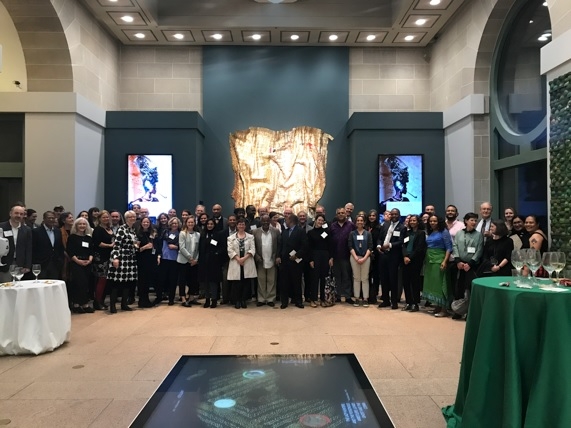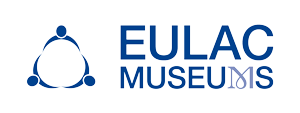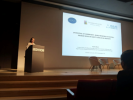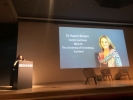Print

News | Noticias | Nouvelles
Title
Third Annual Meeting of the Global Consortium for the Preservation of Cultural Heritage
Image

Participation
International Conference. The preservation of cultural heritage is one of the grand challenges of the contemporary world. The goal of the consortium is to enable the global university, education, and research community to make a transformative contribution to the preservation of cultural heritage, through broad educational programs, major collaborative research initiatives, and effective engagement and advocacy.
This year’s meeting put a special emphasis on discussion of important topics of interest to university and museum professionals. The theme–Museum Communities and Equity–invites participants to explore a range of issues including investigating the role of diverse communities in determining how their heritage is identified, protected, and managed; understanding the needs of the museum and cultural sectors in Africa; and developing creative engagement between cultural institutions and the communities whose heritage they maintain.
For the Session 2: Collections and Communities, this session explores how museums can best collaborate with communities in the selection and management of collections. The role of museums has been changing consistently since the 1960s. Although they continue their traditional activities of preservation, curation, public programming, and education, new questions have emerged: how do museums contribute to sustainable development and the communities to which they belong? The concept of community has been understood in different ways within the social sciences since 1960, and now museums, as trustworthy organizations, have been asked to foster dialogue, build bridges, and increase mutual understanding in a variety of contexts—becoming platforms where creativity combines with knowledge. Communities co-create, share, and interact around the value of museum collections, both as cultural goods and their intangible assets. This participatory approach has impacted the heritage sector, as museums and their collections are perceived as collectively owned property and memory. Responsible to multiple parties, museums can no longer assert a single way of understanding the preservation of cultural heritage, either tangible or intangible. However, a participatory approach has real limits that arise when there are power and economic imbalances, a history of indifference by authorities, or deep-rooted cultural prejudices. How do we build a shared vision for a collection and its many meanings? For example, should we talk about “community” or “communities” when preparing an exhibition? Similarly, we must contemplate how to reinforce the bonds of specific groups in a local or community-based museum, where they often depend on their heritage to assert their identity. How do universities, their museums, and communities collaborate? And what are the best strategies to articulate knowledge-building and knowledge-transfer to communities? Conversely, national and large-scale museums face unique challenges of engagement with their “communities.” What role does digital play in this regard?
Two of our Principal Investigatores were invited to expose:
The Concept of the Museum and the Role of Community Museums and Ecomuseums
Karen Brown, Senior Lecturer in Art History & Museum and Gallery Studies; Director of the School’s Museums, Galleries, and Collections Research Institute, University of St. Andrews (Scotland)
Potential of Community-Based Museums to Foster a Shared Sense of Equity and Local Identity
Karin Weil, Director, Researcher and Project Manager, Museology Department, Universidad Austral de Chile (Chile)
This year’s meeting put a special emphasis on discussion of important topics of interest to university and museum professionals. The theme–Museum Communities and Equity–invites participants to explore a range of issues including investigating the role of diverse communities in determining how their heritage is identified, protected, and managed; understanding the needs of the museum and cultural sectors in Africa; and developing creative engagement between cultural institutions and the communities whose heritage they maintain.
For the Session 2: Collections and Communities, this session explores how museums can best collaborate with communities in the selection and management of collections. The role of museums has been changing consistently since the 1960s. Although they continue their traditional activities of preservation, curation, public programming, and education, new questions have emerged: how do museums contribute to sustainable development and the communities to which they belong? The concept of community has been understood in different ways within the social sciences since 1960, and now museums, as trustworthy organizations, have been asked to foster dialogue, build bridges, and increase mutual understanding in a variety of contexts—becoming platforms where creativity combines with knowledge. Communities co-create, share, and interact around the value of museum collections, both as cultural goods and their intangible assets. This participatory approach has impacted the heritage sector, as museums and their collections are perceived as collectively owned property and memory. Responsible to multiple parties, museums can no longer assert a single way of understanding the preservation of cultural heritage, either tangible or intangible. However, a participatory approach has real limits that arise when there are power and economic imbalances, a history of indifference by authorities, or deep-rooted cultural prejudices. How do we build a shared vision for a collection and its many meanings? For example, should we talk about “community” or “communities” when preparing an exhibition? Similarly, we must contemplate how to reinforce the bonds of specific groups in a local or community-based museum, where they often depend on their heritage to assert their identity. How do universities, their museums, and communities collaborate? And what are the best strategies to articulate knowledge-building and knowledge-transfer to communities? Conversely, national and large-scale museums face unique challenges of engagement with their “communities.” What role does digital play in this regard?
Two of our Principal Investigatores were invited to expose:
The Concept of the Museum and the Role of Community Museums and Ecomuseums
Karen Brown, Senior Lecturer in Art History & Museum and Gallery Studies; Director of the School’s Museums, Galleries, and Collections Research Institute, University of St. Andrews (Scotland)
Potential of Community-Based Museums to Foster a Shared Sense of Equity and Local Identity
Karin Weil, Director, Researcher and Project Manager, Museology Department, Universidad Austral de Chile (Chile)
Place
Smithsonian’s Hirshhorn Museum in Washington, DC
Country
US
Start date
2019-10-21
End date
2019-10-22
Type
Conference
Organisation
Universidad Austral de Chile
PDF document
+ Info
Media
Video



